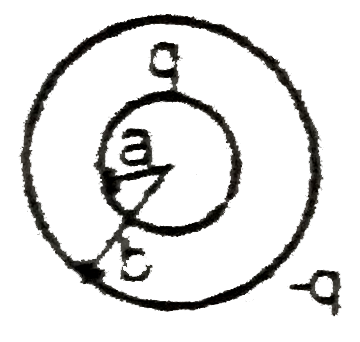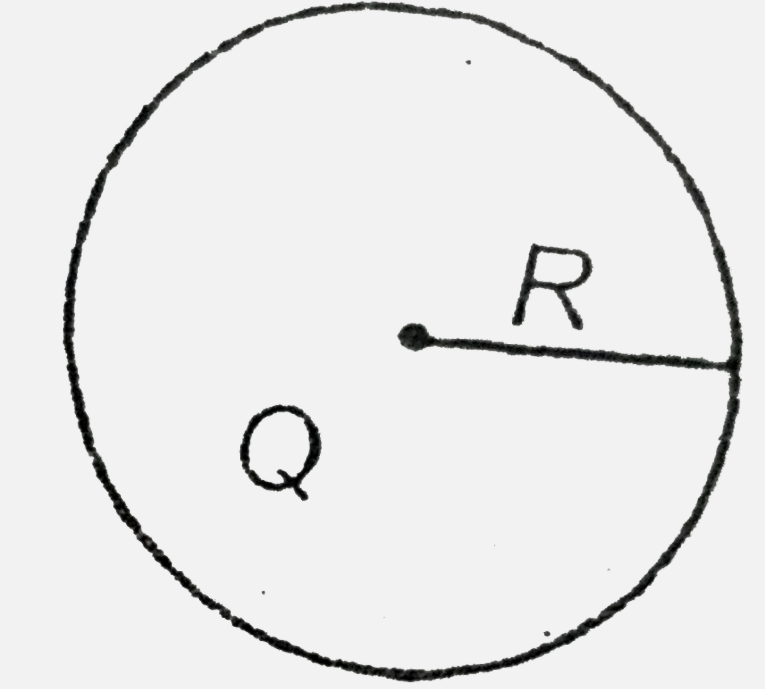Using Gauss' law deduce the expression for the electric field due to a uniformly charged sperical conducting shell of radius R at a point (i) outside and (ii) inside the shell.
Plot a graph showing variation of electric field as a function of r>Randr<R. (r being the distance from the centre of the shell)
To deduce the expression for the electric field due to a uniformly charged spherical conducting shell of radius R at a point outside and inside the shell using Gauss's law, we will follow these steps:
Step 1: Understanding the Setup
Consider a uniformly charged spherical conducting shell of radius R with total charge Q. We need to find the electric field E at a point P which is at a distance r from the center of the shell.
Step 2: Electric Field Outside the Shell (r>R)
1. Choose a Gaussian Surface: For points outside the shell, we choose a spherical Gaussian surface of radius r where r>R.
2. Apply Gauss's Law: According to Gauss's law, the electric flux ΦE through the Gaussian surface is given by:
ΦE=∮E⋅dA=Qencϵ0
Here, Qenc=Q (the total charge on the shell).
3. Calculate the Area: The area A of the Gaussian surface is 4πr2.
4. Substituting into Gauss's Law:
E⋅4πr2=Qϵ0
5. Solve for Electric Field E:
E=Q4πϵ0r2
The direction of the electric field is radially outward from the center of the shell.
Step 3: Electric Field Inside the Shell (r<R)
1. Choose a Gaussian Surface: For points inside the shell, we choose a spherical Gaussian surface of radius r where r<R.
2. Apply Gauss's Law: Again using Gauss's law:
ΦE=∮E⋅dA=Qencϵ0
Here, since there is no charge enclosed within the Gaussian surface (the charge resides on the surface of the conducting shell), we have Qenc=0.
3. Substituting into Gauss's Law:
E⋅4πr2=0
4. Solve for Electric Field E:
E=0
Thus, the electric field inside the conducting shell is zero.
Step 4: Summary of Results
- For r>R:
E=Q4πϵ0r2
- For r<R:
E=0
Step 5: Graphing the Electric Field
- On the graph, plot E on the y-axis and r on the x-axis.
- For r<R, the electric field E is zero (a horizontal line at E=0).
- For r>R, the electric field E decreases with 1r2 (a curve that approaches the x-axis as r increases).
Consider a uniformly charged spherical conducting shell of radius R with total charge Q. We need to find the electric field E at a point P which is at a distance r from the center of the shell.
1. Choose a Gaussian Surface: For points outside the shell, we choose a spherical Gaussian surface of radius r where r>R.
2. Apply Gauss's Law: According to Gauss's law, the electric flux ΦE through the Gaussian surface is given by:
ΦE=∮E⋅dA=Qencϵ0
Here, Qenc=Q (the total charge on the shell).
3. Calculate the Area: The area A of the Gaussian surface is 4πr2.
4. Substituting into Gauss's Law:
E⋅4πr2=Qϵ0
5. Solve for Electric Field E:
E=Q4πϵ0r2
The direction of the electric field is radially outward from the center of the shell.
1. Choose a Gaussian Surface: For points inside the shell, we choose a spherical Gaussian surface of radius r where r<R.
2. Apply Gauss's Law: Again using Gauss's law:
ΦE=∮E⋅dA=Qencϵ0
Here, since there is no charge enclosed within the Gaussian surface (the charge resides on the surface of the conducting shell), we have Qenc=0.
3. Substituting into Gauss's Law:
E⋅4πr2=0
4. Solve for Electric Field E:
E=0
Thus, the electric field inside the conducting shell is zero.
- For r>R:
E=Q4πϵ0r2
- For r<R:
E=0
- On the graph, plot E on the y-axis and r on the x-axis.
- For r<R, the electric field E is zero (a horizontal line at E=0).
- For r>R, the electric field E decreases with 1r2 (a curve that approaches the x-axis as r increases).
Topper's Solved these Questions
- XII BOARDSBOOK - XII BOARD PREVIOUS YEAR PAPER ENGLISHCHAPTER - XII BOARDSEXERCISE - [Set- II]
4 Videos
- XII BOARDSBOOK - XII BOARD PREVIOUS YEAR PAPER ENGLISHCHAPTER - XII BOARDSEXERCISE - [Set-III]
3 Videos
- XII BOARDSBOOK - XII BOARD PREVIOUS YEAR PAPER ENGLISHCHAPTER - XII BOARDSEXERCISE - SET-III, DELHI BOARD
4 Videos
- SAMPLE PAPER 2019BOOK - XII BOARD PREVIOUS YEAR PAPER ENGLISHCHAPTER - SAMPLE PAPER 2019EXERCISE - SECTION D
6 Videos
Similar Questions
Using Gauss's law obtain the expression for the electric field due to uniformly charged thin spherical shell of radius R at a point outside the shell. Draw a graph showing the variation of electric tield with r, for r gt R and r lt R.
View SolutionUsing Gauss's law obtain the expression for the electric field due to uniformly charged thin spherical shell of radius R at a point outside the shell. Draw a graph showing the variation of electric tield with r, for r gt R and r lt R.
View SolutionFind the gravitational potential due to a spherical shell of mass M and radius R at r<R and r>R, where r is the distance from the centre of the shell.
View SolutionFind out energy stored in the electric field of uniformly charged thin spherical shell of total charge Q and radius R.
View SolutionThe electric field due to uniformly charged sphere of radius R as a function of the distance from its centre is represented graphically by
View SolutionThe electrostatic potential of a uniformly charged thin spherical shell of charge Q and radius R at a distance r from the centre
View SolutionFigure shows two concentric shells of radii a and b uniformly distributed charges q and -q. Which of the following graphs gives correct variation of electric field intensity E with the distance r from the centre?

View SolutionInside a charged thin conducting shell of radius R, a point charge +Q is placed as shown in figure potential of shell may be

View SolutionA metallic spherical shell of radius R has a charge -Q on it. A point charge +Q is placed at the centre of the shell. Which of the graphs shown below may correctly represent the variation of electric field E with distance r from the centre of shell ?
View SolutionDraw a plot showing the variation of (i) electric field (E ) and (ii) electric potential (V) with distance r due to a point charge Q.
View Solution
